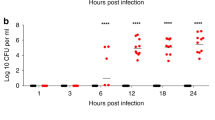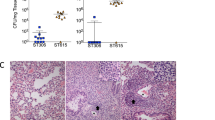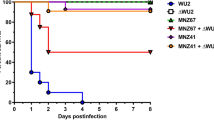Abstract
GRIFFITH1 was the first to show that an attenuated and non-encapsulated 'rough' (R) variant of one specific type of Pneumococcus could be transformed into a virulent and encapsulated 'smooth' (S) form of another specific type. The transformation was accomplished in vivo by injecting subcutaneously a small amount of living R culture of Pneumococcus Type II together with a relatively large inoculum of heat-killed organisms derived from a fully virulent S strain of Pneumococcus Type I or III. The living R strain alone failed to kill mice, whereas the addition of the heat-killed Type I or III organism caused a fatal bacteriæmia. The organism isolated from the heart's blood of the infected animals, however, was not a virulent Type II organism, but a virulent encapsulated Type I or III pneumococcus according to the type of the heat-killed S vaccine employed. The importance of this observation was soon recognized, and Griffith's findings were confirmed by Neufeld and Levinthal2, Baurhenn3 and Dawson4. Some time later, Dawson and Sia5 succeeded in carrying out the transformation of R Type II pneumococci into a virulent S Type III organism by an in tivro procedure.
This is a preview of subscription content, access via your institution
Access options
Subscribe to this journal
Receive 51 print issues and online access
$199.00 per year
only $3.90 per issue
Buy this article
- Purchase on Springer Link
- Instant access to full article PDF
Prices may be subject to local taxes which are calculated during checkout
Similar content being viewed by others
References
Griffith, F., J. Hyg., 27, 113 (1928).
Neufeld, F., and Levinthal, W., Z. Imm. Forsch., 55, 324 (1928).
Baurhenn, W., Centr. Bakt., 1, Abt., Orig., 126, 68 (1932).
Dawson, M. H., J. Exp. Med., 51, 123 (1930).
Dawson, M. H., and Sia, R. H. P., J. Exp. Med., 54, 681 (1931).
Dawson, M. H., and Avery, O. T., Proc. Soc. Exp. Biol. and Med., 24, 943 (1927).
Alloway, J. L., J. Exp. Med., 55, 91 (1932); 57, 265 (1933).
Reeves, R. E., and Goebel, W. F., J. Biol. Chem., 139, 511 (1941).
Avery, O. T., MacLeod, C. M., and McCarty, M., J. Exp. Med., 79, 137 (1944).
Signer, R., Caspersson, T., and Hammersten, E., NATURE, 141, 122 (1938).
Astbury, W. T., and Bell, F., NATURE, 141, 747 (1938).
Feulgen, R., Z. physiol. Chem., 92, 154 (1914).
Thompson, R. H. S., and Dubos, R. J., J. Biol. Chem., 125, 65 (1938).
Schaffer, A. J., Folkoff, C., and Bayne-Jones, Bull. Johns Hopkins Hosp., 33, 151 (1922).
Johnson, T. B., and Brown, E. B., J. Biol. Chem., 54, 721, 731 (1922).
Lackman, D., Mudd, S., Sevag, M. G., Smolens, J., and Wiener, M., J. Immunol, 40, 1 (1941).
Sevag, M. G., Lackman, D., and Smolens, J., J. Biol. Chem., 124, 425 (1938).
Berry, G. P., and Dedrick, H. M., J. Bact., 31, 50 (1936).
Berry, G. P., Arch. Path., 24, 533 (1937).
Author information
Authors and Affiliations
Rights and permissions
About this article
Cite this article
MORGAN, W. Transformation of Pneumococcal Types. Nature 153, 763–764 (1944). https://doi.org/10.1038/153763a0
Issue Date:
DOI: https://doi.org/10.1038/153763a0
This article is cited by
-
Bacterial Transformation and the Origins of Epidemics in the Interwar Period: The Epidemiological Significance of Fred Griffith’s “Transforming Experiment”
Journal of the History of Biology (2016)
-
Mitosegifte und cancerogene Faktoren als Antibiotica
Zeitschrift f�r Krebsforschung (1948)
Comments
By submitting a comment you agree to abide by our Terms and Community Guidelines. If you find something abusive or that does not comply with our terms or guidelines please flag it as inappropriate.



